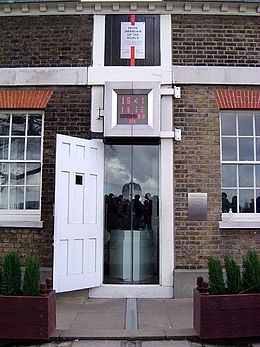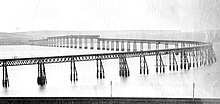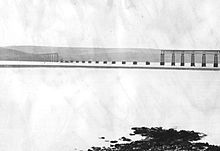George Biddell Airy
George Peacock |
|---|
Sir George Biddell Airy
Biography
Airy was born at Alnwick, one of a long line of Airys who traced their descent back to a family of the same name residing at Kentmere, in Westmorland, in the 14th century. The branch to which he belonged, having suffered in the English Civil War, moved to Lincolnshire and became farmers. Airy was educated first at elementary schools in Hereford, and afterwards at Colchester Royal Grammar School.[1] An introverted child, Airy gained popularity with his schoolmates through his great skill in the construction of peashooters.[2]
From the age of 13, Airy stayed frequently with his uncle, Arthur Biddell at
Research

Some idea of his activity as a writer on mathematical and physical subjects during these early years may be gathered from the fact that previous to this appointment he had contributed three important memoirs to the Philosophical Transactions of the
Airy's writings during this time are divided between mathematical physics and astronomy. The former are for the most part concerned with questions relating to the theory of light arising out of his professorial lectures, among which may be specially mentioned his paper On the Diffraction of an Object-Glass with Circular Aperture, and his enunciation of the complete theory of the
One of the sections of his able and instructive report was devoted to "A Comparison of the Progress of Astronomy in England with that in other Countries", very much to the disadvantage of England. This reproach was subsequently to a great extent removed by his own labours.[8]
Mean density of the Earth
One of the most remarkable of Airy's researches was his determination of the
Reference geoid
In 1830, Airy calculated the lengths of the polar radius and equatorial radius of the earth using measurements taken in the UK. Although his measurements were superseded by more accurate radius figures (such as those used for
Planetary inequalities
Airy's discovery of a new inequality in the motions of Venus and the Earth is in some respects his most remarkable achievement. In correcting the elements of Delambre's solar tables he had been led to suspect an inequality overlooked by their constructor. The cause of this he did not long seek in vain; thirteen times the mean motion of Venus is so nearly equal to eight times that of Earth that the difference amounts to only a small fraction of Earth's mean motion, and from the fact that the term depending on this difference, although very small in itself, receives in the integration of the differential equations a multiplier of about 2,200,000, Airy was led to infer the existence of a sensible inequality extending over 240 years (Phil. Trans. cxxii. 67). The investigation was probably the most laborious that had been made up to Airy's time in planetary theory, and represented the first specific improvement in the solar tables effected in England since the establishment of the theory of gravity. In recognition of this work the Gold Medal of the Royal Astronomical Society was awarded to him in 1833[8] (he would win it again in 1846).
Airy disk
The resolution of optical devices is limited by diffraction. So even the most perfect lens can't quite generate a point image at its focus, but instead there is a bright central pattern now called the Airy disk, surrounded by concentric rings comprising an Airy pattern. The size of the Airy disk depends on the light wavelength and the size of the aperture. John Herschel had previously described the phenomenon,[12] but Airy was the first to explain it theoretically.[13]
This was a key argument in refuting one of the last remaining arguments for absolute
Astronomer Royal

In June 1835 Airy was appointed

The formidable undertaking of reducing the accumulated planetary observations made at Greenwich from 1750 to 1830 was already in progress under Airy's supervision when he became Astronomer Royal. Shortly afterwards he undertook the further laborious task of reducing the enormous mass of observations of the moon made at Greenwich during the same period under the direction, successively, of James Bradley, Nathaniel Bliss, Nevil Maskelyne and John Pond, to defray the expense of which a large sum of money was allotted by the Treasury. As a result, no fewer than 8,000 lunar observations were rescued from oblivion, and were, in 1846, placed at the disposal of astronomers in such a form that they could be used directly for comparison with the theory and for the improvement of the tables of the moon's motion.[8]
For this work Airy received in 1848 a testimonial from the
In 1851 Airy established a new
Search for Neptune

In June 1846, Airy started corresponding with French astronomer Urbain Le Verrier over the latter's prediction that irregularities in the motion of Uranus were due to a so-far unobserved body. Aware that Cambridge Astronomer John Couch Adams had suggested that he had made similar predictions, on 9 July Airy urged James Challis to undertake a systematic search in the hope of securing the triumph of discovery for Britain. Ultimately, a rival search in Berlin by Johann Gottfried Galle, instigated by Le Verrier, won the race for priority.[17] Though Airy was "abused most savagely both by English and French"[18] for his failure to act on Adams's suggestions more promptly, there have also been claims that Adams's communications had been vague and dilatory[17] and further that the search for a new planet was not the responsibility of the Astronomer Royal.[19]
Ether drag test
Using a water-filled
Lunar theory
In 1872 Airy conceived the idea of treating the lunar theory in a new way, and at the age of seventy-one he embarked on the prodigious toil which this scheme entailed. A general description of his method will be found in the Monthly Notices of the Royal Astronomical Society, vol. xxxiv, No. 3. It consisted essentially in the adoption of Charles-Eugène Delaunay's final numerical expressions for longitude, latitude, and parallax, with a symbolic term attached to each number, the value of which was to be determined by substitution in the equations of motion.[8]
In this mode of treating the question the order of the terms is numerical, and though the amount of labour is such as might well have deterred a younger man, yet the details were easy, and a great part of it might be entrusted to "a mere
The work was published in 1886, when its author was eighty-five years of age. For some little time previously he had been harassed by a suspicion that certain errors had crept into the computations, and accordingly he addressed himself to the task of revision. But his powers were no longer what they had been, and he was never able to examine sufficiently into the matter. In 1890 he tells us how a grievous error had been committed in one of the first steps, and pathetically adds, "My spirit in the work was broken, and I have never heartily proceeded with it since."[8]
Engineering mechanics
Stress function method
In 1862, Airy presented a new technique to determine the
Tay Bridge disaster


Airy was consulted about wind speeds and pressures likely to be encountered on the proposed Forth suspension bridge being designed by Thomas Bouch for the North British Railway in the late 1870s. He thought that pressures no greater than about 10 pounds per square foot (500 pascals) could be expected, a comment Bouch took to mean also applied to the first Tay railway bridge then being built. Much greater pressures, however, can be expected in severe storms. Airy was called to give evidence before the Official Inquiry into the Tay Bridge disaster, and was criticised for his advice. However, little was known about the problems of wind resistance of large structures, and a Royal Commission on Wind Pressure was asked to conduct research into the problem.[23]
Controversy
Airy was described in his obituary published by the
Private life
In July 1824, Airy met Richarda Smith (1804–1875), "a great beauty", on a walking tour of Derbyshire. He later wrote, "Our eyes met ... and my fate was sealed ... I felt irresistibly that we must be united," and Airy proposed two days later. Richarda's father, the Revd Richard Smith, felt that Airy lacked the financial resources to marry his daughter. Only in 1830, with Airy established in his Cambridge position, was permission for the marriage granted.[17][28][29]
The Airys had nine children, the first three of whom died young.
- Elizabeth Airy (born 1833) died of consumption (tuberculosis) in 1852.
- The eldest child to survive to adulthood was Wilfrid (1836–1925), who designed and engineered "Colonel" George Tomline's Orwell Park Observatory.[30][31] Wilfrid's daughter was the artist Anna Airy.[31]Anna's mother died shortly after she was born and she was raised by her maiden aunts Christabel and Annot (see below).
- George Airy's son Hubert Airy (1838–1903) was a doctor, and a pioneer in the study of migraine.[32] Airy himself suffered from this condition.
- The Airys' eldest daughter, Hilda (1840–1916), married the mathematician Edward Routh in 1864.[33]
- Christabel (1842–1917) died unmarried, as did the next sister Annot (1843–1924).
- The Airys youngest child was Osmund (1845–1929).
Airy was knighted on 17 June 1872.[34]
Airy retired in 1881, living with his two unmarried daughters at
Sir Patrick Moore asserted in his autobiography that the ghost of Airy has been seen haunting the Royal Greenwich Observatory after nightfall. (page 178)
Legacy and honours
- Elected president of the Royal Astronomical Society four times, for a total of seven years (1835–37, 1849–51, 1853–55, 1863–64). No other person has been president more than four times (a record he shares with Francis Baily).[37]
- Foreign Honorary Member of the American Academy of Arts and Sciences (1832)[38]
- The Airy is named for him.[39][40] Within that crater lies another smaller crater called Airy-0 whose location defines the prime meridian of that planet, as does the location of Airy's 1850 telescope for Earth.[41]
- winner of the Lalande Prize for astronomy from the French Academy of Sciences, 1834
- Elected as a member of the American Philosophical Society in 1879.[42]
- There is also a
- The Airy disc and Airy points.
- Honorary Fellow of the Institution of Engineering and Technology.[45]
Bibliography


- By Airy
For a list of works by George Biddell Airy (with digital copies) see Wikisource.
A complete list of Airy's 518 printed papers is in Airy (1896). Among the most important are:
- (1826) Mathematical Tracts on Physical Astronomy
- (1828) On the Lunar Theory, The Figure of the Earth, Precession and Nutation, and Calculus of Variations, to which, in the second edition of 1828, were added tracts on the Planetary Theory and the Undulatory Theory of Light
- (1834) Gravitation: an Elementary Explanation of the Principal Perturbations in the Solar System (Full text at Internet Archive)
- (1839) Experiments on Iron-built Ships, instituted for the purpose of discovering a correction for the deviation of the Compass produced-by the Iron of the Ships
- (1848 [1881, 10th edition]) Popular Astronomy: A Series of Lectures Delivered at Ipswich (Full text at Wikisource)
- (1855) A Treatise on Trigonometry (Full text at Google Books)
- (1861) On the Algebraic and Numerical Theory of Errors of Observations and the Combination of Observations.
- (1866) An Elementary Treatise on Partial Differential Equations (Full text at Internet Archive)
- (1868) On Sound and Atmospheric Vibrations with the Mathematical Elements of Music (Full text at MPIWG)
- (1870) A Treatise on Magnetism (Full text at Google Books)
- About Airy
- Airy, George Biddell; Wilfrid, Airy (1896). The Autobiography of Sir George Biddell Airy. Cambridge University Press. p. 342. OCLC 13130558. Retrieved 24 February 2008.
edward maunder astronomer.
- Cannon, W.F. (November 1964). "Scientists and broad churchmen: an early Victorian intellectual network". The Journal of British Studies. 4 (1): 65–88. S2CID 42948903.
- Satterthwaite, G. E. (2003). "Airy's zenith telescopes and "the Birth-Star of Modern Astronomy"". Journal of Astronomical History and Heritage. 6 (1). James Cook University: 13. S2CID 117043816.
- Winterburn, E. (2002). "The Airy Transit Circle". British History – Victorians. BBC. Retrieved 9 September 2007.
See also
References
Notes
- ^ At the time that this was written, the term "computer" referred to a human being who performed calculating work, either manually or with mechanical aids.
Citations
- ^ a b c Rambaut 1911, p. 445.
- ^ O'Connor, John J.; Robertson, Edmund F., "George Biddell Airy", MacTutor History of Mathematics Archive, University of St Andrews
- ^ Autobiography of Sir George Biddel Airy (see Google books)
- ^ Sir George Biddell Airy KCB. Leaflet available from Playford church
- ^ "Airy, George Biddell (ARY819GB)". A Cambridge Alumni Database. University of Cambridge.
- ^ "Sir George Biddell Airy (1801–1892)". Royal Netherlands Academy of Arts and Sciences. Retrieved 19 July 2015.
- ^ Rambaut 1911, pp. 445–446.
- ^ a b c d e f g h i Rambaut 1911, p. 446.
- .
- ^ "WGS84 and the Greenwich Meridian". Royal Observatory, Greenwich. Retrieved 9 May 2014.
- ^ "A Guide to Coordinate Systems" (PDF). Ordnance Survey. Archived from the original (PDF) on 4 April 2016. Retrieved 9 May 2014.
- ^ Herschel, J. F. W., "Light," in Transactions Treatises on physical astronomy, light and sound contributed to the Encyclopaedia Metropolitana, Richard Griffin & Co., 1828, p. 491.
- ^ Airy, G. B., "On the Diffraction of an Object-glass with Circular Aperture," Transactions of the Cambridge Philosophical Society, Vol. 5, 1835, pp. 283–291.
- Bibcode:2006AntAs...3...83S.
- ISBN 0-19-215948-8.
- S2CID 4108225.
- ^ doi:10.1093/ref:odnb/251. (Subscription or UK public library membershiprequired.)
- OCLC 13130558. Retrieved 24 February 2008.
edward maunder astronomer.
- doi:10.1093/ref:odnb/123. (Subscription or UK public library membershiprequired.)
- .
- .
- .
- ISBN 0-7524-3160-9.
- ISBN 978-1-78326-917-4.
- S2CID 123788388.
- ^ Swade, D. D. "Calculation and Tabulation in the Nineteenth Century: Airy versus Babbage" (PDF). Doron Swade's PhD Thesis. Retrieved 22 June 2016.
- S2CID 122410786.
- Bibcode:1998AsNow..12...43C.
- S2CID 162033494.
- ^ Goward, K.J. (2005). "G B Airy's Country Retreat". Institute of Astronomy. University of Cambridge. Archived from the original on 7 August 2007. Retrieved 9 September 2007.
- ^ a b Goward, Kenneth J (2006). "Founding of Orwell Park Observatory". Institute of Astronomy. University of Cambridge. Archived from the original on 15 November 2007. Retrieved 16 December 2007.
- PMID 20608346.
- doi:10.1093/ref:odnb/35850. (Subscription or UK public library membershiprequired.)
- ^ "No. 23868". The London Gazette. 18 June 1872. p. 2801.
- ^ "What would goods and services costing". Inflation Calculator. Bank of England. Retrieved 21 March 2022.
- ^ A description and images of Airy's Suffolk cottage and church are found in Goward (2005)
- ^ "LIST OF PRESIDENTS AND DATES OF OFFICE". A brief history of the RAS. Royal Astronomical Society. Retrieved 10 September 2012.
- ^ "Book of Members, 1780–2010: Chapter A" (PDF). American Academy of Arts and Sciences. Retrieved 6 April 2011.
- ^ "Mars Nomenclature: Crater, craters". Gazetteer of Planetary Nomenclature. USGS: Astrogeology Research Program. Retrieved 16 August 2007.
- ^ "George Biddell Airy". University of New Brunswick Libraries. Retrieved 6 November 2017.
- ISBN 0-312-24551-3.
- ^ "APS Member History". search.amphilsoc.org. Retrieved 12 May 2021.
- ISBN 0-936389-27-3.
- ISBN 978-0-521-86028-4.
- ^ "Honorary Fellows list". www.theiet.org. Retrieved 5 January 2022.
Sources
- This article incorporates text from a publication now in the public domain: Rambaut, Arthur Alcock (1911). "Airy, Sir George Biddell". In Chisholm, Hugh (ed.). Encyclopædia Britannica. Vol. 1 (11th ed.). Cambridge University Press. pp. 445–447.
Further reading
- Anonymous (1896). "SIR GEORGE AIRY (1801–1891) (Obituary Notice, Tuesday, 5 January 1892)". Eminent Persons: Biographies reprinted from The Times. Vol. V (1891–1892). London: Macmillan and Co. pp. 178–182. Retrieved 8 March 2019 – via Internet Archive.
Obituaries
- E. J. R., Proceedings of the Royal Society, 51 (1892), i–xii
- The Times, 5 January 1892
- East Anglian Daily Times, 11 January 1892
- Suffolk Chronicle, 9 January 1892
- Daily Times, 5 January 1892
- "Obituary – Sir George Biddell Airy". Monthly Notices of the Royal Astronomical Society. 52: 212–229. 1892. .
- Proceedings of the Institution of Civil Engineers, 108 (1891–92), 391–394
- Astronomical Journal 11 (1892) 96
- Astronomische Nachrichten 129 (1892) 33/34
- The Observatory 15 (1892) 73
- Obituary in: . Popular Science Monthly. Vol. 40. April 1892.
External links
 Works by or about George Biddell Airy at Wikisource
Works by or about George Biddell Airy at Wikisource
- . ISSN 0161-7370 – via Wikisource.
- O'Connor, John J.; Robertson, Edmund F., "George Biddell Airy", MacTutor History of Mathematics Archive, University of St Andrews
- Portraits of George Biddell Airy at the National Portrait Gallery, London
- Works by George Biddell Airy at Project Gutenberg
- Works by Wilfrid Airy at Project Gutenberg
- Works by or about George Biddell Airy at Internet Archive
- Awarding of RAS gold medal, 1833: MNRAS 2 (1833) 159
- Awarding of RAS gold medal, 1846: MNRAS 7 (1846) 64
- ScienceWorld.
- Mathematical Tracts on the Lunar and Planetary Theories 4th edition (London, McMillan, 1858)
- Full texts of some of the papers by Airy are available at Gallica: bibliothèque numérique de la Bibliothèque nationale de France
- "Archival material relating to George Biddell Airy". UK National Archives.
